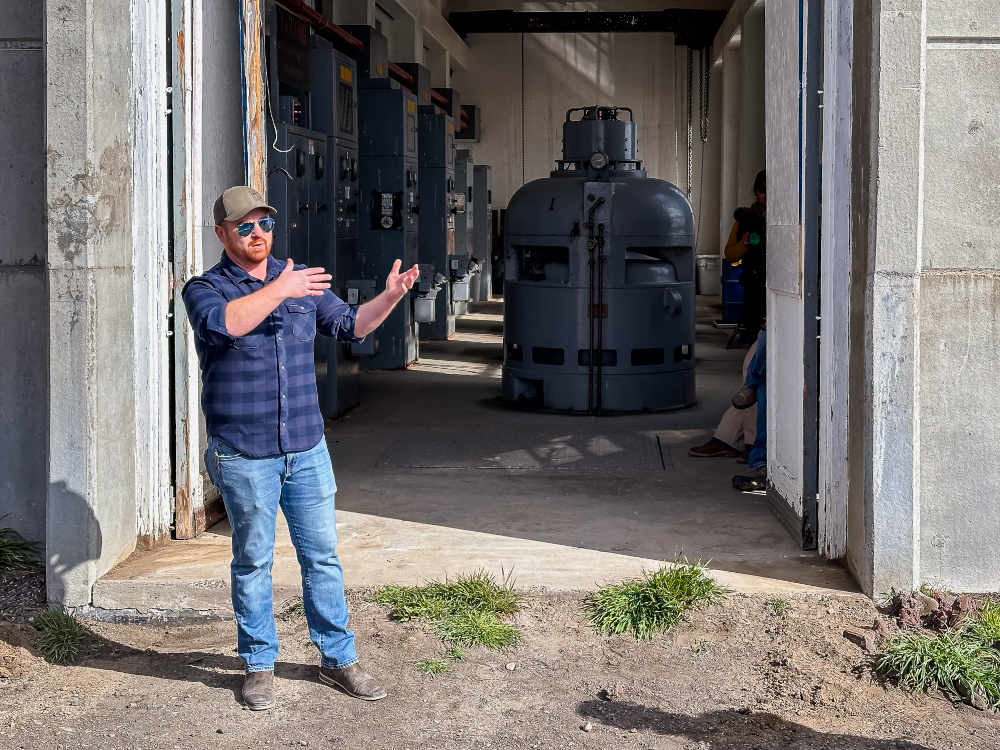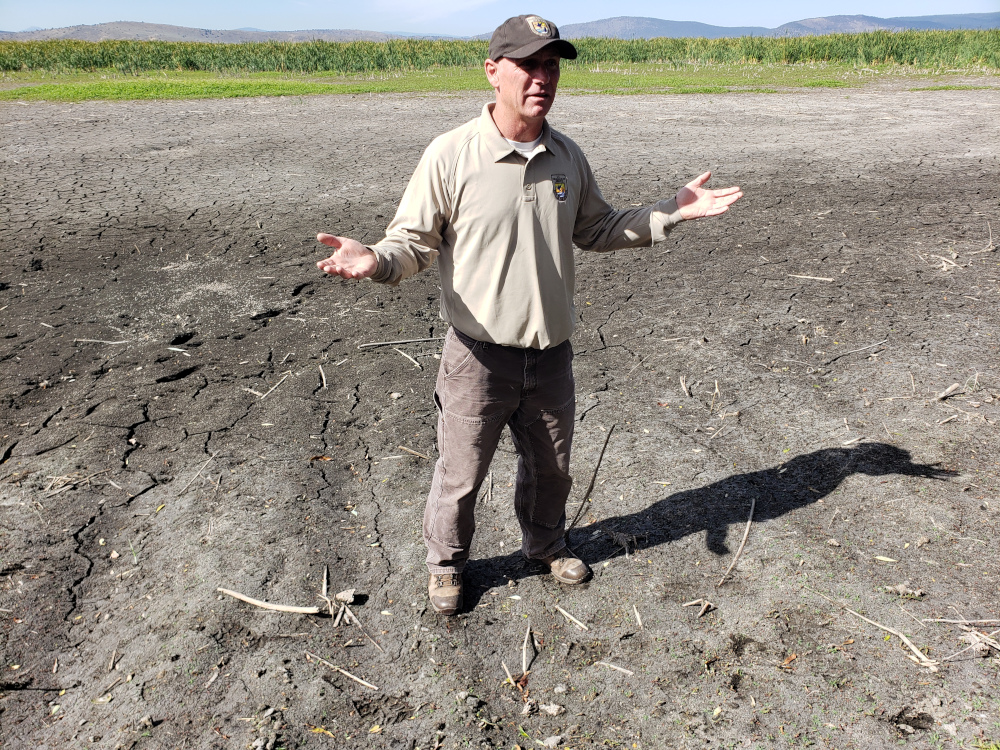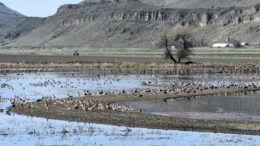Tule Lake National Wildlife Refuge, located in far Northern California, harbors what remains of a once vast, shallow lake. On a recent April morning, I toured the area with John Vradenburg, supervisory fish and wildlife biologist for the Klamath Basin Refuges. A few months earlier, birds had all but abandoned Tule Lake. Now they were back in the thousands: clumps of eared grebes; dipping swallows; black-necked stilts with their impossibly spindly legs.
As we drove along the edge of the refuge’s largest wetland — evocatively called “Sump 1A” — pairs of Canada geese swam away from shore, followed by fluffy goslings. Vradenburg stopped the truck to rescue one that was trapped behind a headgate. He gently tossed the ball of fluff into the water, where it made a beeline for its two siblings.
View this post on Instagram
A few yards later Vradenburg stopped again to point out a pair of western grebes. Facing each other, they took turns dipping their needle-like bills into the water, then shook them off. They were getting ready to dance, side by side, across the water — part of their spectacular courtship ritual.
“It’s just so good to see birds moving around in here again,” he said.
A Transformed Ecosystem
The Klamath Basin National Wildlife Refuges are a complex of six refuges straddling the Oregon-California border — remnants of vast wetlands that once expanded and contracted with the seasons, breathing an almost unfathomable abundance of life into the dry region. A century or so ago, flocks of geese and swans darkened the sky. There were masses of white pelicans; hordes of grebes, ducks, and ibises; eagles and hawks in profusion. On Lower Klamath Lake, which sprawled nearly 100,000 acres, boats conveyed tourists from the Klamath River to the lake’s southern tip.
In typical early 20th century fashion, the Bureau of Reclamation remade the basin into a network of dikes, canals, drains, sumps and pumps called the Klamath Reclamation Project. Both Lower Klamath Lake and Tule Lake were drained to feed new farms established by homesteaders, including veterans returning from both World Wars.
To preserve what remained of the shrinking habitat, President Theodore Roosevelt in 1908 established the Lower Klamath National Wildlife Refuge. At nearly 47,000 acres, it was the nation’s first wildlife refuge dedicated to waterfowl. The 39,000-acre Tule Lake refuge was established in 1928 to protect what was left of the drained expanse.
Though a fraction of their former splendor, these wetlands still serve as a vital stopover for the millions of birds that use the Pacific Flyway every year.
The region has always experienced periodic drought, but the past 20 years have been drier than usual, culminating in several years of extreme to exceptional drought. Between 2019 and 2022, the Lower Klamath and Tule Lake refuges received essentially no water. Wetlands like Sump 1A turned to cracked expanses of dry mud. The birds disappeared.
Now, thanks to two decent water years in a row and a surge of funding for restoration projects across the Klamath Basin, a new optimism about reconnecting this broken ecosystem has emerged.
Reconnecting the Pieces
On March 24 members of the Tulelake Irrigation District gathered in front of a blocky concrete building for an unlikely ceremony: the revving up of “D plant,” a series of pumps that route water from Tule Lake to the Lower Klamath refuge via a 6,000-foot tunnel. The plant used to run nearly continuously, moving some 80,000 acre-feet of water per year, but it had been silent since 2020. (One acre-foot of water is about 326,000 gallons.)
Ironically, this ecosystem now needs D Plant, says Brad Kirby, manager of the Tulelake Irrigation District. In this remade basin, the Lower Klamath refuge is cut off from the Klamath River; D Plant functions like a heart, powering an artificial artery that delivers lifeblood to the refuge. This water also helps recharge the aquifer and eventually drains back to the Klamath River underground.

Typically, irrigators want to conserve every drop. Encouraging the “flow through” of water among farmland, wetlands, and the river is a “new goal, counter to when I first started, when our goal was to minimize drainage,” says Kirby.
The Klamath Refuge system and farmers of the Klamath Project have long been intertwined. Farmland surrounds the refuges; in addition, 21,000 acres within the refuges are leased for agriculture.
Even though the refuges hold a senior water right — an older right with higher priority — they are the last to receive water.
First priority goes to three endangered species. The Bureau of Reclamation must manage flows in the Klamath River to protect coho salmon and levels in Upper Klamath Lake to ensure the survival of c’waam and koptu — sucker fish that are of critical importance to the Klamath Tribes.
Next the agency must fulfill contracts with irrigators. The refuges largely depend on drain water from the irrigation districts — and that’s in good years.
The Klamath Basin has a fraught history, with Tribes, irrigators, and wildlife advocates fighting over scarce and precious resources. The recent drought showed everyone — refuge staff, irrigators, tribes, hunters — the unthinkable: the “Everglades of the West” transformed into a desert. This vision scared stakeholders to the table to hammer out solutions that benefit the landscape as a whole, and, they hope, everyone.
“It’s the first time — at least since I’ve seen here — where you see everyone interested in what everyone else has going on, and everyone participating in a proactive, collaborative way,” says Vradenburg. “You hear a lot about co-benefits.” Wetlands absorb and slowly release water, filter out pollutants, recharge groundwater, and provide habitat for birds and fish.
View this post on Instagram
“The thing that’s different from the historic Klamath Basin to today is the connectivity,” says Vradenburg. “Can we look at the infrastructure that we have in this highly modified system and bring that connectivity back?”
Across the basin working groups are looking at ways to restore wetlands and “re-wet the sponge.” Ducks Unlimited, which helped secure funding to run D Plant, is working with area irrigation districts to improve water conveyance and management. The nonprofit has secured funding from the U.S. Fish and Wildlife Service to install new pumping stations to deliver agricultural drain water to the Lower Klamath Wildlife Refuge. Money from that same pot will go to improve management of the wetlands — or “sumps” — on Tule Lake refuge.
The current infrastructure “is not set up to handle this new paradigm of less water,” says Amelia Raquel, a regional biologist at Ducks Unlimited.
It’s not just the quantity of wet ground that’s important — it’s the timing. Prolonged drying can be devastating, allowing invasive species to take root and even causing land to sink, or subside. But managing wetlands so they go dry for shorter periods “resets the whole health of that wetland,” says Raquel. “This allows the seedbank in wetland soils to germinate, starts succession [and] brings in invertebrates food for waterfowl and fish.”

The Klamath Drainage District has proposed modifying one of the main diversions that delivers irrigation water from the Klamath River so that it first enters a large wetland in the Lower Klamath Wildlife Refuge. This would provide important habitat for ducks and other waterfowl, especially during spring and summer molting and breeding seasons. It would also benefit fish, including salmon that will have access to the Upper Basin once dams on the Klamath River are removed this year.
“The reason we started thinking about this is we had a dry refuge,” says Scott White, general manager of the Klamath Drainage District. Birds need habitat in spring. “If they’re not going to the refuge, then they’re out in the fields as the little baby plants are starting to grow, munching away. They just wreak havoc on a crop.”
The district is also looking at using some of their private farmlands as floodplain habitat, similar to the way rice fields in California’s Central Valley function.
This project is one part of a new memorandum of understanding signed between the Klamath Water Users Association, Klamath Tribes, Yurok Tribe, and Karuk Tribe. In it the parties agreed to work together on projects that support their common goals, and the Department of Interior pledged to help secure funding.
Some of the old tension remains. Irrigators are disappointed with the Bureau of Reclamation’s latest water allocation, announced in April; they feel they should have received more water on the heels of such a wet winter. Clayton Dumont, chairman of the Klamath Tribes, is also worried about the allocation. He supports projects that restore wetlands and functionality of the ecosystem, but he also wants to make sure none of these projects further compromise c’waam and koptu in Upper Klamath Lake.
“We’re not interested in having the refuges fill at the expense of suckers in the upper basin,” he says.
And the shadow of the next drought is never far.
A Resilient Landscape
The refuge wetlands are still recovering from being dry for so long. At Tule Lake submerged aquatic vegetation is starting to return — a good sign, says Vradenburg. “That’s a really a big driver for a lot of our waterbird communities, especially diving ducks and grebes, those birds that like to nest on top of the water.”
On our way back to refuge headquarters, we stopped to watch a small flock of ibis pick through the mud, their glossy backs flashing green and rust. Then we stopped yet again to listen to the insistent murmur of hundreds, maybe thousands, of white-fronted geese. While the Canada geese are already rearing families, these birds still have to make it all the way to their breeding grounds in Alaska.
It’s a different landscape from just two years ago. During the drought going to work every day was heartbreak, says Vradenburg. “The refuge staff was so beaten down. Now people are grabbing keys to a work vehicle just so they can see the birds flying at sunrise.”

Get more from The Revelator. Subscribe to our newsletter, or follow us on Facebook and LinkedIn.
Previously in The Revelator:
The Monumental Effort to Replant the Klamath River Dam Reservoirs



![[CALIFORNIA-J-0025] Tule Lake farms](https://live.staticflickr.com/65535/50376853913_f03ac52008_b.jpg)
